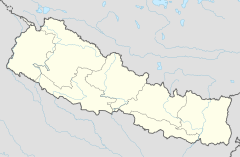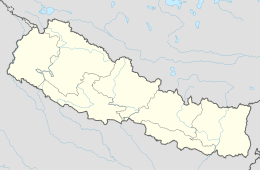| Muktinath Temple | |
|---|---|
 The temple of Muktinath ('lord of liberation or moksha') during winter months | |
| Religion | |
| Affiliation | Hinduism, Buddhism |
| District | Mustang District |
| Deity | Vishnu |
| Features |
|
| Location | |
| Location | Muktinath (Dhawalagiri) |
| Country | Nepal |
Location in Nepal | |
| Geographic coordinates | 28°49′01″N 83°52′18″E / 28.816854°N 83.871742°E |
| Architecture | |
| Type | Pagoda |
| Elevation | 3,762 m (12,343 ft) |
Muktinath is an ancient Vishnu temple located in Mustang, Nepal. The temple of Muktinath, known as 'the lord of liberation', is sacred to both Hindus and Buddhists whom they worship as an abode of Hindu deity Vishnu and Buddhist deity Avalokiteśvara respectively.[1][2][3] Located in the Muktinath valley at the foot of the Thorong La mountain pass, it is one of the world's highest temples at an altitude of 3,800 meters. The temple is given a status of one of the 108 Divya Desams of Hinduism and the only Divya Desam located outside India. It is also one of the 51 Shakta pithas, associated with the head of goddess Sati. [4] The temple complex is known as Mukti Kshetra, which literally means "the place of liberation (moksha)" and is one of the Char Dham in Nepal.[1]
For Buddhists, Muktinath is an abode of dakinis - goddesses known as Sky Dancers and is considered one of the twenty-four Tantric places. Tibetan Buddhists call it Chumig Gyatsa, which in Tibetan means "Hundred Waters" and the murti is revered as a manifestation of Avalokiteśvara, who embodies the compassion of all Buddhas.[5]
Muktinath temple is seen as a symbol of religious harmony in Nepal where both the Hindus and Buddhists have been historically worshipping on the same spot, mutually respecting and including each other.[6]
- ^ a b "Nepal's Top Pilgrimage and Holy Sites – The Abode of Spirituality". Nepali Sansar. 2019-03-30. Retrieved 2020-12-14.]
- ^ "Brief history of Muktinath-Chumig Gyatsa at the Annapurna Circuit - Nepal". muktinath.org. Retrieved 2024-06-28.
- ^ "Muktinath Temple". templesofindia.co. 2024-04-13. Retrieved 2024-06-28.
- ^ Alightindia. "Muktinath Temple - History, information & Temple timings". Muktinath Temple - History, information & Temple timings. Retrieved 2024-06-28.
- ^ Zurick, David (2006). Illustrated Atlas of the Himalayas. Lexington: University Press of Kentucky. p. 153.
- ^ Cite error: The named reference
:1was invoked but never defined (see the help page).

